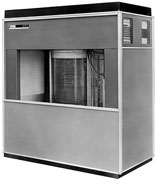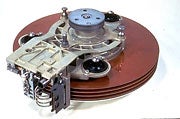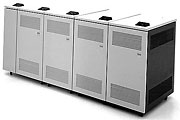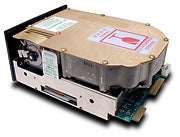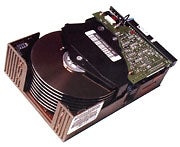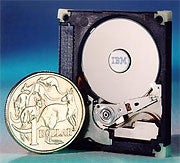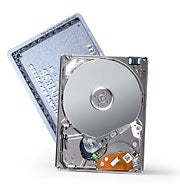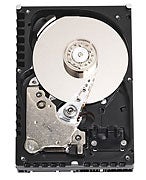In 1953 IBM recognized the immediate application for what it termed a "Random Access File" having high capacity and rapid random access at a relatively low cost. After considering technologies such as wire matrices, rod arrays, drums, drum arrays, etc., the engineers at IBM's San Jose California laboratory invented the hard disk drive. The disk drive created a new level in the computer data hierarchy, then termed Random Access Storage but today known as secondary storage, less expensive and slower than main memory (then typically drums) but faster and more expensive than tape drives.[3]
The commercial usage of hard disk drives began in 1956 with the shipment of an IBM 305 RAMAC system including IBM Model 350 disk storage.
Each generation of disk drives replaced larger, more sensitive and more cumbersome devices. The earliest drives were usable only in the protected environment of a data center. Later generations progressively reached factories, offices and homes, eventually reaching ubiquity.
Disk media diameter was nominally 8 or 14 inches (200 or 360 mm) and were typically mounted in standalone boxes (resembling washing machines) or large equipment rack enclosures. Individual drives often required high-current AC power due to the large motors required to spin the large disks. Hard disk drives were not commonly used with microcomputers until after 1980, when Seagate Technology introduced the ST-506, the first 5.25 inches (133 mm) drive.
The capacity of hard drives has grown exponentially over time. When hard drives became available for personal computers, they offered 5-megabyte capacity. During the mid-1990s the typical hard disk drive for a PC had a capacity of about 1 gigabyte. As of January 2012, desktop hard disk drives typically had a capacity of 500 to 2000 gigabytes, while the largest-capacity drives were 4 terabytes.
Timeline
- 1956 – IBM 350, first commercial disk drive, 5 million characters (6-bit).
- 1961 – IBM 1301 Disk Storage Unit introduced with one head per surface and aerodynamic flying heads, 28 million characters (6-bit) per module.
- 1961 – Bryant Computer Products division of Ex-Cell-O, 1 meter platters, 1200 RPM, up to 205MB.
- 1962 – IBM 1311 introduced removable disk packs containing 6 disks, storing 2 million characters per pack
- 1964 – IBM 2311 with 7.25 megabytes per disk pack
- 1964 – IBM 2310 removable cartridge disk drive with 1.02 MB on one disk
- 1965 – IBM 2314 with 11 disks and 29 MB per disk pack
- 1968 – Memorex is first to ship an IBM-plug-compatible disk drive
- 1970 – IBM 3330 Merlin, introduced error correction, 100 MB per disk pack
- 1973 – IBM 3340 Winchester introduced removable sealed disk packs that included head and arm assembly, 35 or 70 MB per pack
- 1973 – CDC SMD announced and shipped, 40 MB disk pack
- 1976 – 1976 IBM 3350 "Madrid" – 317.5 Megabytes, eight 14" disks, Re-introduction of disk drive with fixed disk media
- 1979 – IBM 3370 introduced thin film heads, 571 MB, non-removable
- 1979 – 1979 IBM 62PC "Piccolo" – 64.5 Megabytes, six 8" disks, First 8-inch HDD
- 1980 – The world's first gigabyte-capacity disk drive (2.52 GB), the IBM 3380, was the size of a refrigerator, weighed 249 kg, and had a price tag of 40,000 USD which is 114,491 USD in present day terms.
- 1980 – ST-506 first 51⁄4 inch drive released with capacity of 5 megabytes, cost 1500 USD
- 1983 – RO351/RO352 first 31⁄2 inch drive released with capacity of 10 megabytes
- 1986 – Standardization of SCSI
- 1988 – PrairieTek 220 – 20 Megabytes, two 2.5" disks, First 2.5 inch HDD.
- 1989 – Jimmy Zhu and H. Neal Bertram from UCSD proposed exchange decoupled granular microstructure for thin film disk storage media, still used today.
- 1990 – 1990 IBM 0681 "Redwing" – 857 Megabytes, twelve 5.25" disks. First HDD with PRML Technology (Digital Read Channel with 'Partial Response Maximum Likelihood' algorithm)
- 1991 – IBM 0663 "Corsair" – 1,004 Megabytes, eight 3.5" disks; first HDD using magnetoresistive heads
- 1991 – Integral Peripherals 1820 "Mustang" – 21.4 Megabytes, one 1.8" disk, first 1.8 inch HDD
- 1992 – HP Kittyhawk first 1.3-inch hard-disk drive –
- 1993 – IBM 3390 model 9, the last Single Large Expensive Disk drive announced by IBM
- 1994 – IBM introduces Laser Textured Landing Zones (LZT)
- 1997 – IBM Deskstar 16GP "Titan" – 16,800 Megabytes, five 3.5" disks; first (Giant Magnetoresistance) heads
- 1997 – Seagate introduces the first hard drive with fluid bearings
- 1998 – UltraDMA/33 and ATAPI standardized
- 1999 – IBM releases the Microdrive in 170 MB and 340 MB capacities
- 2002 – 137 GB addressing space barrier broken
- 2003 – Serial ATA introduced
- 2003 – IBM sells disk drive division to Hitachi
- 2004 – MK2001MTN first 0.85 inch drive released by Toshiba with capacity of 2 gigabytes
- 2005 – First 500 GB hard drive shipping (Hitachi GST)
- 2005 – Serial ATA 3Gbit/s standardized
- 2005 – Seagate introduces Tunnel MagnetoResistive Read Sensor (TMR) and Thermal Spacing Control
- 2005 – Introduction of faster SAS (Serial Attached SCSI)
- 2005 – First perpendicular magnetic recording (PMR) HDD shipped: Toshiba 1.8-inch 40/80 GB
- 2006 – First 750 GB hard drive (Seagate)
- 2006 – First 200 GB 2.5" hard drive utilizing perpendicular recording (Toshiba)
- 2006 – Fujitsu develops heat-assisted magnetic recording (HAMR) that could one day achieve one terabit per square inch densities.
- 2007 – First 1 terabyte hard drive (Hitachi GST)
- 2008 – First 1.5 terabyte hard drive (Seagate)
- 2009 – First 2.0 terabyte hard drive (Western Digital)
- 2010 – First 3.0 terabyte hard drive (Seagate, Western Digital)
- 2010 – First Hard Drive Manufactured by using the Advanced Format of 4,096 bytes a block ("4K") instead of 512 bytes a block
- 2011 – First 4.0 terabyte hard drive (Seagate)
- 2012 – Western Digital announces the first 2.5-inch, 5mm thick drive, and the first 2.5-inch, 7mm thick drive with two platters. (Western Digital)
- 2012 – HGST announces helium-filled hard disk drives, promising cooler operation and the ability to increase the maximum number of platters from five to seven in the 3.5" form factor. (Hitachi GST)
- 2012 – TDK demonstrates 2 TB on a single 3.5-inch platter
- 2012 – Toshiba re-enters the 3.5" desktop hard disk drive market with capacities up to 3 TB. This is made possible by the Federal Trade Commission demanding that Western Digital and Hitachi GST give assets and intellectual property rights to Toshiba. Prior to this, Toshiba had only manufactured 2.5" laptop HDDs for many years.
- 2013 – Seagate announces that it will ship hard disk drives with capacities up to 5 TB using shingled magnetic recording (SMR), a method where tracks are written to partially overlap each other. The read head, being smaller, can still read the overlapped tracks.
- 2013 – HGST announces a helium-filled 6 TB hard disk drive for enterprise applications.
- 2013 – Western Digital demonstrates heat assisted magnetic recording (HAMR) technology.
- 2014 – Seagate introduces 6 TB hard drives that do not use helium, in turn increasing their power consumption and lowering their overall cost.
- 2014 – Seagate ships worlds first 8 TB hard drives.
- 2014 - Western Digital's HGST subsidiary sampling 10 TB hard drives filled with helium.
Manufacturing History
- 1967: Hitachi enters the HDD business
- 1967: Toshiba enters the HDD business
- 1979: Seagate Technology founded.
- 1988: Western Digital, then a well-known controller designer, enters the HDD business by acquiring Tandon Corporation's disk manufacturing division.
- 1988: Samsung enters the worldwide HDD market, previously having manufactured Comport disk drives for the Korean market.
- 1989: Seagate purchases Control Data's HDD business.
- 1990: Maxtor purchases MiniScribe out of bankruptcy, making it the core of its low-end HDDs.
- 1994: Quantum purchases DEC's storage division, giving it a high-end disk range to go with its more consumer-oriented ProDrive range.
- 1996: Seagate acquires Conner Peripherals in a merger.
- 2000: Maxtor acquires Quantum's HDD business; Quantum remains in the tape business.
- 2003: Hitachi acquires the majority of IBM's disk division, renaming it Hitachi Global Storage Technologies (HGST).
- 2006: Seagate acquires Maxtor.
- 2009: Toshiba acquires Fujitsu's HDD division.
- 2011: Western Digital proposes acquiring Hitachi's HDD division.
- 2011: Seagate acquires Samsung's HDD division.
- 2012: Western Digital acquires Hitachi Global Storage Technologies.
- 2012: Seagate acquires Lacie.
